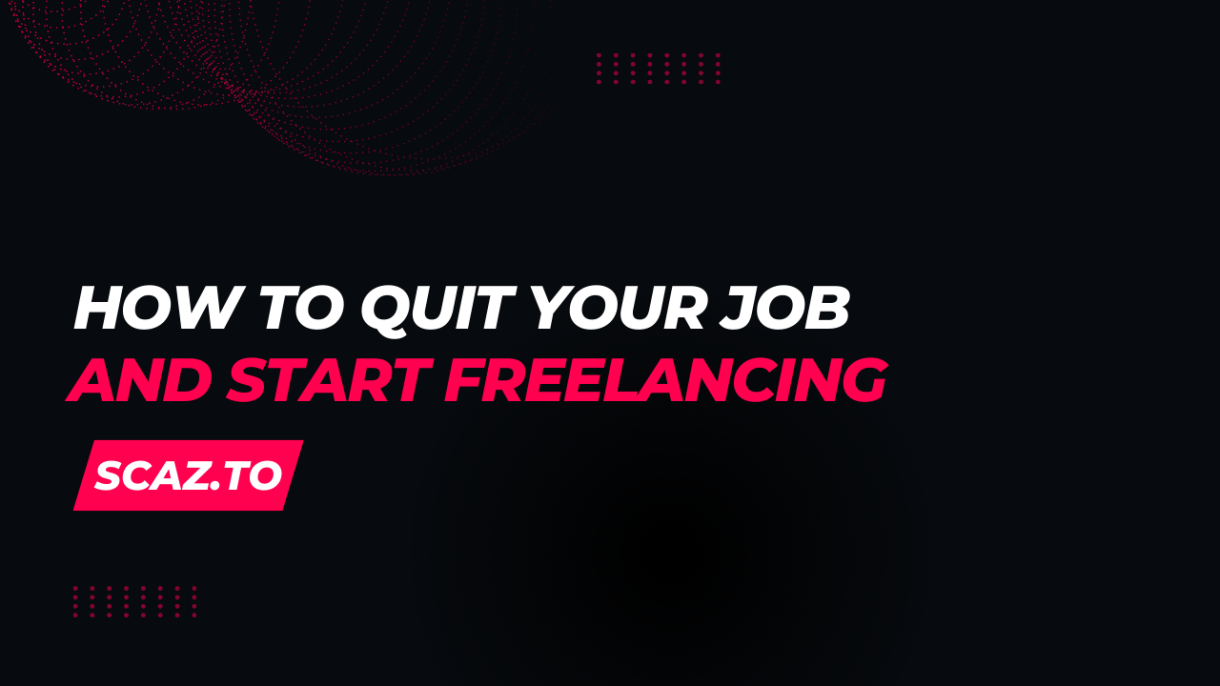Do you despise Mondays?
Do you despise having to report to your boss every day?
Then you’re probably already fantasizing about quitting your job, right?
You’ve come to the right place if you’re looking for the best way to safely quit your job without taking any risks.
In this article, I will walk you through a simple 6-step process for quitting your job while also developing a proper strategy to cover your expenses and pay your bills so you can start freelancing.
You Don’t Have To Quit
Whether you’re working for a corporate company that you despise, are stuck in a dead-end job, or are simply looking for a way to make more money, you shouldn’t quit on the spur of the moment without a plan.
In fact, you should not give up. Not yet!
Many successful freelancers and entrepreneurs have built successful careers and businesses while working full-time.
Craig Newmark was once a regular guy like you. He had a great job at IBM, then moved on to work at Charles Schwab Corporation, and then to another company called Continuity Solutions. He was never completely satisfied with these jobs.
He started a small email list while working at this day job to help him find local events and meet new people. He referred to it as “Craig’s list.” This email list quickly became more than just a personal list for events. So he created a website to assist more people in finding events, apartments, and other services.
Craig decided to leave his job in 1999 after the website began to grow and turn it into a business. Craigslist is now the name of this website, and Craig has a net worth of $1.31 billion.
The moral of the story is that you never know how successful your side project will be. So there’s no harm in giving it a shot.
There’s no reason to jeopardize your financial stability or endanger your family. Begin your side hustle while still working your day job. Slowly build it up to a stable income, and then you can safely quit your job you despise and do work you truly enjoy and are good at.
Here’s how to get started with that procedure.
Step 1: Pick A Goal That Scares You
I always wanted to be an author since I was a kid. To be well-known for writing great novels.
But being an author was never a viable way to make a living. At least not in my country. So, after dropping out of high school, I needed to find a “real job.”
I worked several day jobs before realizing that my true passion is writing. I took a chance and quit my job to pursue my dream of becoming a writer, and it eventually paid off.
Working at my day job always made me feel depressed. Even so, quitting the job felt like a big risk. However, my desire to become a writer gave me the confidence to take that risk. And I worked tirelessly to achieve that goal, no matter what.
To succeed in your career, you must find a similar goal that scares you the most. It will assist you in breaking free from your comfort zone and discovering your true potential.
Whether you want to earn more money to buy a house, pay for your child’s college fund, or save for a trip around the world, set a big and specific goal to keep you motivated to work hard.
Because freelancing entails a substantial amount of work. You’ll need that motivation to get you through the difficult times.
Step 2: Create A Budget And Start Saving
It’s always a good idea to have a safety net in place in case something goes wrong.
Begin saving money for at least three months’ worth of expenses and bills before quitting your job.
That way, even if you can’t find a new client or one of your clients cancels in the middle of a contract, you’ll be able to keep working as a freelancer without having to resort to desperate measures.
Make a budget to plan how you’ll spend your money once you start freelancing full-time. Determine how much you’ll need to earn each month to cover your expenses, and plan how you’ll spend and reinvest your money.
Step 3: Take Time To Improve Your Skills
As a freelancer, you will provide services based on your expertise.
It’s also critical that you’re exceptional at what you do in order to compete with more experienced freelancers.
Don’t start looking for work just yet. Instead, begin honing your skills in order to meet the demands.
For example, if you enjoy writing and want to make money as a writer, you can enroll in online courses to learn how to write for online audiences, how to format articles, and how to optimize content for search engines.
Today, you can learn almost any skill and become a professional by taking an online course.
However, taking online courses and reading books is insufficient. You should also practice your skills.
I used to be a bad writer. Then I started a blog and continued to write every day. I wrote over 6500 blog posts. This assisted me in honing my writing skills and obtaining better clients willing to pay higher rates for my skills.
I’m still not a very good writer. My skills could be better. That’s why I spend my extra money on new online courses and books every month.
Allow yourself plenty of time. Learn new skills and practice until you are proficient. Then, create a portfolio of your work.
Get a couple of your articles published on popular blogs if you’re a writer. Try contributing to a website design or releasing a free website template if you’re a web designer.
Find a way to establish a name for yourself. So that when clients inquire about your work, you can proudly send them links to your portfolio.
Step 4: Start Freelancing On The Side
You can begin pitching to clients once you are confident in your skill set and have a portfolio.
To begin, you can sign up for a freelancing marketplace or use a job board to find gigs. Simply avoid popular platforms like UpWork, Freelancer, and Fiverr.
Set aside 2-3 hours each day for your side hustle to work on your freelancing gigs when you get home from work.
You’ll have to make some sacrifices to make more time. However, if you truly want to succeed as a freelancer and earn more money, giving up a couple of hours of sleep or canceling your Netflix subscription won’t be too difficult.
Step 5: Find Long-Term Clients
It took me a long time to realize that having one long-term client is far superior to having five small clients.
This is essential for establishing financial security as a freelancer.
I used to have to find new clients to work with every month. Needless to say, this was a difficult process, especially dealing with rejection.
After I teamed up with a couple of clients on long-term projects, I was able to relax and focus on delivering great work.
I no longer had to look for clients or worry about paying the bills for the next month. Every month, these clients gave me work.
Before you quit your job, try to find a couple of clients who will give you long-term contracts.
I understand that this is easier said than done, particularly for freelancers in fields like web design and coding. But if you’re inventive enough, you’ll figure it out.
Perhaps you’ll come across a web design firm that will invite you to work part-time for them or a company that will hire you to develop their blog as a contributor. You can find companies hiring remote workers using platforms like AngelList.
Step 6: Go All-In
If you want to win big in poker, you must take a risk and bet all of your money on the hand you have. So, just like in poker, if you want to make more money freelancing, you must have full confidence in your skillset and work more hours to earn more money.
Fortunately, you’ll already have a couple of long-term contracts from clients at this point. As a result, you can easily quit your day job without taking a significant risk.
Freelancing is still fraught with danger. There will be times when you are unable to find clients or are awaiting payment after completing a job.
As a result, you will be tempted not to quit your day job. However, it is up to you to decide whether it is a risk worth taking or whether you should continue working at the job you despise for the rest of your life.
Remember that every successful person you can think of today, from Bill Gates to Steve Jobs, took a risk to do something they truly loved and believed in at some point in their lives. That is what set them apart from the competition.
How to Make It Work After You Have Quit
Making it work after you quit your job is the most difficult part.
Working from home is a challenge in and of itself. Avoiding distractions and concentrating on work while also managing day-to-day tasks at home is a difficult task, especially if you are married or have children.
Make sure you have the right tools to make your life easier, and try out productivity hacks like the 52/17 Rule to find ways to focus and finish your work on time.


